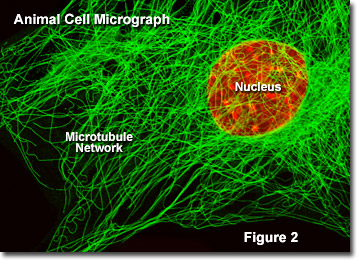 Daily Newsletter
Daily Newsletter
September 12, 2012 Cytoskeleton
The cell is not just a fluid filled sack, but an organized structure complete with internal supports. Consider it a high rise building that is just squishy. Creating the structure are a protein fibers (structural proteins). Structural proteins typically are in quaternary structures, meaning that individual proteins combine to create the overall structure. The cytoskeleton is composed of Microtubules, Microfilaments, and a group of proteins referred to as the Intermediate Filaments.

The microtubules are one of the most well studied cytoskeletal elements. They are composed of the protein tublin, and are responsible for the flagella, mitotic spindles, internal structure, and movement of materials and vesicles within the cell (they act as roads on which vesicles are carried).
Microfilamentsare composed of actin. They help to form structure, and are used in movement, such as muscle contraction, the formation of pseudopods and bulk transport.
The intermediate filaments are a family of structural proteins that are smaller than microtubules, but larger than microfilaments. There are a number of different types, and some are specific for a given cell type. Wikiepdia provides a good list of the different types of intermediate filaments in the article intermediate filaments.
 Spectrin is a structural protein that was originally classified as an intermediate filament. In recent years, the importance of this protein to the cell membrane has become more noted, so it deserves it's own place. The structure of spectrin has it reclassifed as related to actin (microfilaments).
Spectrin is a structural protein that was originally classified as an intermediate filament. In recent years, the importance of this protein to the cell membrane has become more noted, so it deserves it's own place. The structure of spectrin has it reclassifed as related to actin (microfilaments).
The cytoskeleton plays a major role with movement within the cell, especially when it comes to forming organelles and moving vesicles. We see the cytoskeleton helping to form the nuclear envelop (the nulcear lamella), and are important in the disappearance of the nucleus during cell division. They are also responsible for the shape of the endoplasmic reticulum, formation of vesicles and the Golgi body, as well as the incorporation of vesicles into the cell membrane.
The endomembranous system, which includes the endoplasmic reticulum and Golgi body (apparatus). This system is critical for the proper formation of proteins that will be associated with the membrane, other organells, or secreted from the cell. The rough endoplasmic reticulum (which get's its name due to the presence of ribosomes on the surface of the ER) is the location of protein synthesis for proteins with the above listed fate. The smooth endoplasmic reticulum is a place of protein processing and lipid (especially phospholipid) synthesis. It is in the smooth endoplasmic reticulum that we see the production of new phospholipid bilayer components (i.e., phospholipids).

Daily Challenge
Today, you are to describe in brief the function of the cytoskeletal elements listed above. You do not need to go in depth about the structure, at present the function is more important. Pick one of the above cytoskeletal elements to be your focus today. Write more about that element, including it's structure. Do not neglect the other components.Link to Forum

No comments:
Post a Comment